You won’t believe it!
The concept behind Mark Lengel’s Telemark Tech System binding is so simple it’s a wonder no one tried it before. Perhaps there was a quack or two out there who did and didn’t even believe it themselves, or they thought no one else would, so they abandoned it (after all, they’re quacks).It seems odd that the common view from backcountry’s religious sect know as telemarkers — who originally espoused light and simple gear for traveling in the mountains — would not recognize the value of the Dynafit system for enhancing a free heel. But as pinheaded telemarkers we didn’t – probably because telemarkers have been as poisoned and deluded with the bigger is better concept as much or more so than alpine skiers. Witness the trend in tele for phat skis, stiff 4-buckle monster boots and, consequently, heavy metal cable bindings.
As a tribe I can guarantee it’s going to take some time for pinheads to open their minds to the possibilities that the Tele Tech System (TTS) provides. However, when they do it will spawn a new generation of ski alpinists we’ve only been able to dream about until today.
But I digress here actually because what, at the moment, is most interesting to notice is how telemarkers have fallen prey to the same syndrome that most alpine skiers are duped by. Their eyes deceive them and they think that Dynafit or, more generically, Tech bindings simply aren’t strong enough to do the job. Their small size is undeniably the cause.
I remember the first time I spotted a pair. We were skinning up the west ridge of Baldy Bowl, on 10,040-foot San Antonio in 1990. I’d heard about these puny little bindings that the Euros were using when we chanced upon a guy wearing a pair. No one believed such a small binding could actually hold a man to a pair of skis.Ordinarily we’d just stare at any new gear we saw in the field since it was obvious the gear we used needed improvement. This time we stopped the guy and asked if he’d let us really look at ‘em. He knew exactly what we needed to see, so he disengaged and let us inspect ‘em up close. They were so small they defied belief. Indeed, from the get go that’s what Dynafit bindings do.
Even if they did hold, there’s no way they could provide any reasonable measure of release safety. The wearer admitted as much, but laughed it off by saying he hardly ever needed release and besides, as far as he could tell, they released whenever they should so he had no complaints. We figured he was just loopy ‘cuz he probably drank too much French wine and those Euros were funny anyway. Besides, there’s no way something that small could go the distance. It might be light and it might release exactly as he said but there was no way those things would last more than 30 or 40 days without breaking.
Such it seems is the instinctive reaction to Dynafit bindings. We think that for something to be strong it needs to be massive and beefy. Yet when you stop to consider other examples in life you realize that brute force is rarely the way to go, especially when there is a more elegant solution possible. So it is with Dynafit, replacing raw power with strategic power. It takes a while for your mind to accept it, which is why I’ve long maintained that Dynafit tests a man’s faith because you won’t see that it works until you believe that it works.Contrary to the popular myth that we believe in something after we have seen it, quite often you won’t see the value in something until you first believe it. Any man or woman who has a strong religious faith realizes the importance of that premise. It can literally turn your view of the world upside down, or in the case of the transformation of Ramer’s tuning fork release plate to a pair of Dynafit toe nipples — inside out. (early history of Dynafit here)
And this is the thing that is so ironic, since telemarkers have earned a reputation as religious zealots for proselytizing their manner of turning. Just as new backcountry converts have a hard time wrapping their head around the idea that a binding as small as the Dynafit can even keep you reliably attached to your ski let alone be more durable than a massive hunk like the Duke, telemarkers can’t believe the same things. That’s the problem when your belief gets watered down with sound bite dogma and you stop using your brain.
I’ve had similar ideas floating in my head for years but Mark Lengel made those ideas into drawings, then real pieces of material that incorporate the Dynafit toe with a tele cable. There is no doubt he also questioned the veracity of those steel nipples to hold a tele boot while flexing. Except he had enough faith to test if what he believed was really so. And I’m here to say, it’s a go. If you’re not sure, then I simply need to echo what I’ve told new turn earning alpine skiers for years – you just need to have faith that it really works.Despite being an ardent promoter of Dynafit to my locked heel friends, I shared your lack of confidence for the ability of such a small package to work for tele too. It just couldn’t possible be strong enough to hold your toe while cranking a tele turn, and certainly not repeatedly. But it only took a nudge from Mark Lengel for me to see it was possible and now that I’ve tried it, my belief in the Tech system as the future of bindings for ski alpinists is rather firm.
This use of tech toes for tele has me wondering about G3’s long term plans with Onyx too. Even if they are working on something for tele, rest assured this writer would be among the last people on earth G3 would share that information with. Therefore, their denial of a new tele binding can be categorically dismissed.Since it is very rare for any concept to be pursued by only one party at a time, I’m sure they’re playing with ways to make Onyx the do it all binding. I don’t think it is a coincidence that the toe and heel pieces slide on a nifty universal mounting track, or that the heel piece slides to the rear to disengage, something a switch hitter would want so they could free the heel or hold it tight, without having to exit the binding. Nor is G3 blind to the potential for NTN, especially for boots with a Tech fitting in the toe.
If you can reduce the weight of the tele side of the package to only two pounds by using a tech system toe, it isn’t asking that much to add back the weight of a rando-racing style heel for occasional pitches with a locked heel. No, this wouldn’t have the safety factor of a Duke, or even a Dynafit ST, but whenever I’ve wanted a locked heel, safety was defined by not releasing. Even teleheads who are weight conscious would be willing to carry 3 pounds if it offered vestiges of release and the ability to use a single rig that’s bi-sensual. Locked heel for when you want a firm foot to drive your edges or the sweet flex of a tele turn wherever you prefer it.
The Caveat
Now I don’t mean to be hypocritical here in acknowledging the fly in the ointment of my faith in Dynafit. There is one item that remains to be seen – the durability of a tech system toe subjected to telemark’s notoriously destructive forces over time. That it performs admirably on the tour and turning is no longer a question. How long it lasts before wearing out or breaking remains to be seen. The telemark turn stresses a binding more than a parallel turn, of that there is no doubt. However I remain confident that durability can be theoretically improved with a change in materials.
Conclusion
The recognition that a tech toe works as well in the tele realm as it does in the alpine, perhaps even better, is good news for those with an alpinist view, especially those who are bi-sensual.
© 2011
Related Articles
BackcountryTalk thread – TTS, strength, weaknesses, workarounds
Verdict on the TeleTechSystem binding

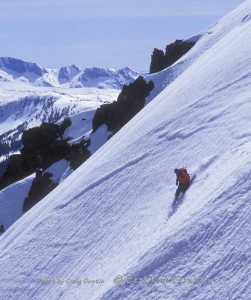
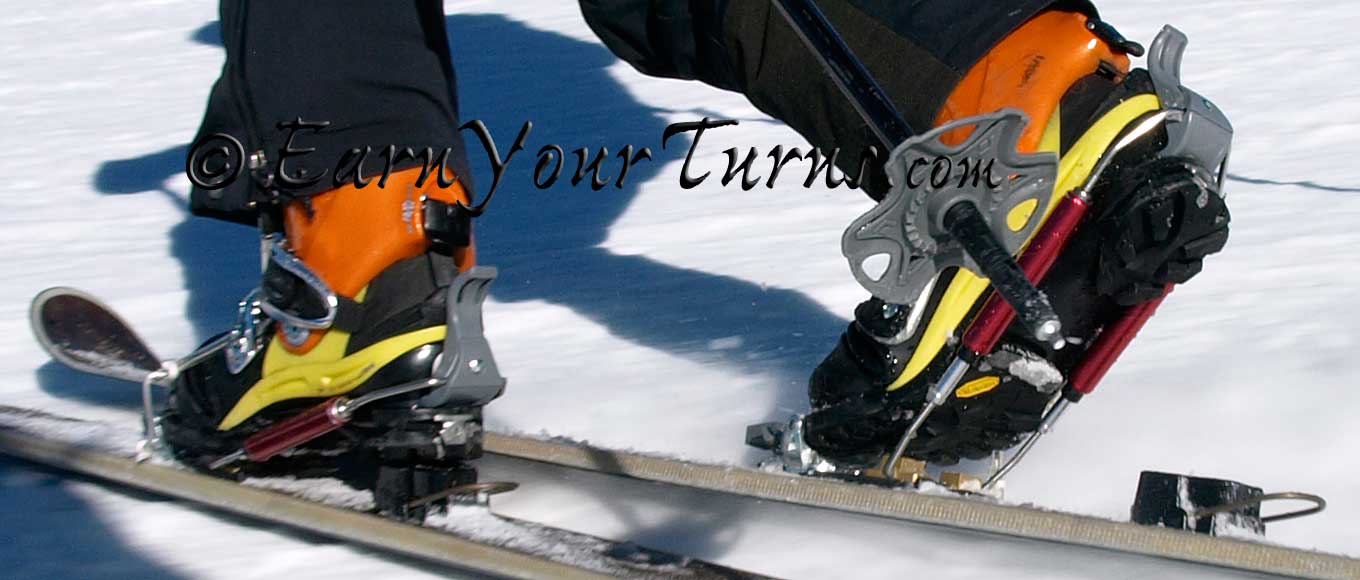
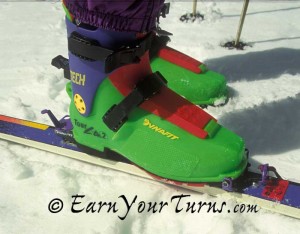
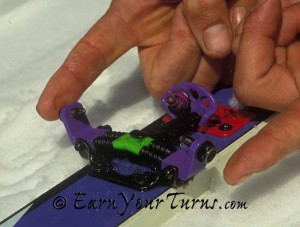
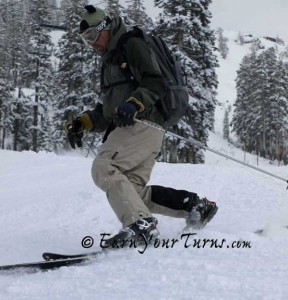
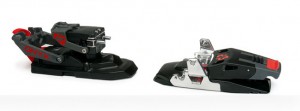
24 pings
Skip to comment form
[…] Dynafit goes bi-sensual. Can you believe it? The importance of adapting a Dynafit binding to work as an integral part of a telemark system. Source: http://www.earnyourturns.com […]
[…] F1 for those who chose to migrate to the NTN norm along the Dynafit style path illustrated by the Telemark Tech System (TTS), a hybrid NTN binding. Backcountry favors a free-pivot The Telemark Tech System […]
[…] Posts Spike TTS: Version 2.0, Mantis, Dynafit goes bisensual Rottefella’s NTN […]
[…] 2014 Related Posts Verdict on TTS Dynafit goes Bisensual Review of TTS v2.0 BCTalk Thread: TTS strengths, weaknesses, […]